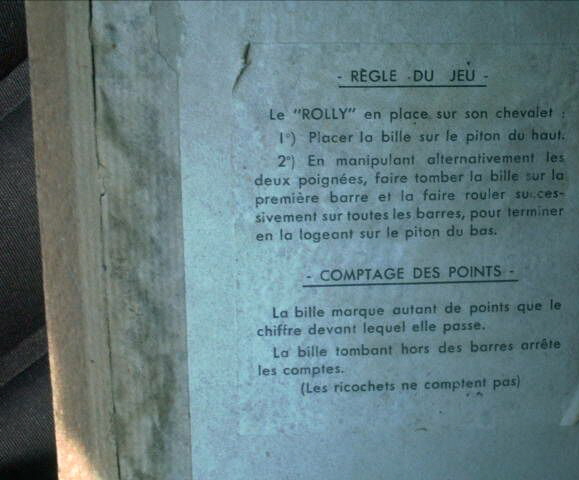|
Rolly
It is probably highly debatable whether this is a puzzle at all. It verges on being a game, but I wanted to show it, and it does require a lot of dexterity. It is as much a dexterity puzzle as a Journet puzzle, so I am happy to include it here. I’ve had many discussions with fellow mechanical puzzle collectors on whether dexterity puzzle are in fact puzzles at all, but my personal view is that as they do generally require logical thought as well as balance and a steady hand, they are mechanical puzzles.
I found this wonderful item languishing by the road side at a flea market in a street in the Loire valley in France in about 1993. I paid £12. I’ve never seen another one, and I have failed to find any reference to it in any book or on the Internet, so if anyone can tell me anything about it, I would very much like to hear from you.
It measures fourteen inches wide and twenty inches high. It is about three quarters of an inch thick and stands on a table top like an easel. It has a single hinged prop at the back. The two levers in the bottom corners are just under nine inches long. The text under the word ROLLY says “Brevete – marque et modele deposes US Patent Nr 2,223,981.” The label on the back gives instructions, although the object seems perfectly obvious.
The horizontal bars are just under nine inches long and four tenths of an inch in cross section. The metal strips holding the bars in place are twelve inches long. The back board is plywood, about a tenth of an inch thick. It is a bit warped in the centre at the bottom from water damage. In the top left and bottom right corners are simple screw eyes.
Play commences by standing Rolly on a table, and placing a ball bearing or small marble on the screw eye at the top. By pushing down on the left lever, which is loosely secured to the frame at its mid point by a pivot screw, the left ends of all the bars move upwards. About half an inch in from the left end of the top bar is a vertical nail, which will push the ball off the screw eye and on to the top bar. Then all that remains is for judicious use of the two pivoting levers to allow the slow and steady descent of the ball from one bar to the next lower one, until it arrives on the lowest bar. Finally, careful manipulation of the levers will allow the ball to progress along the lowest bar and jump off onto the lower screw eye. Unless of course the ball fell off the ends of one of the ten earlier rods. 150 points for going all the way, and other scores are obtained from the score above the bar from which you fall.
 |
The above picture shows the reverse. This is seriously riveting entertainment!! I have managed to complete the perilous journey, but it is very difficult. Perhaps we should do away with roadside alcohol breathalyser tests and make successful completion of Rolly the new test for sobriety?
I have no idea of the age of Rolly, perhaps the US patent number will give someone a clue. I would guess mid sixties, but I have no real idea.
|


